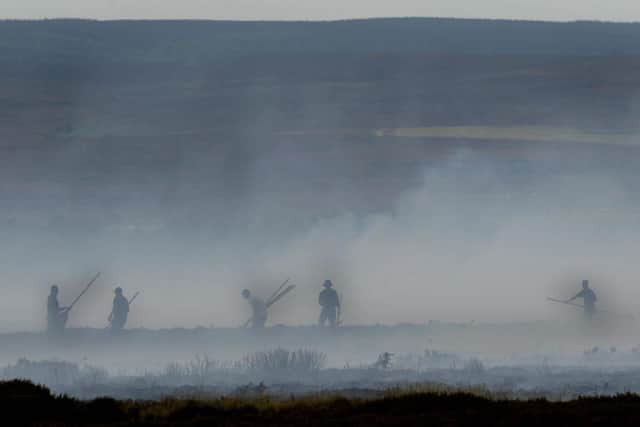Fire risks in the North York Moors National Park will only become greater - Bernie McLinden
Fylingdales Moor is a flourishing haven for wildlife, especially the birds of prey which make it their home. It’s different from other moorlands in the North York Moors National Park as it isn’t used for grouse shooting. Instead, it is managed using traditional techniques to help moorland birds thrive. Some heather is still intentionally burned each year to produce a patchwork of new shoots for red grouse to eat. But other stands of heather are left to grow taller, providing a more welcoming habitat for birds including the merlin (Britain’s smallest falcon) and the short-eared owl.
This moorland is thriving today, but in 2003 it was destroyed by a wildfire that burnt for six days and stripped away an area of peat and heather the size of 500 football pitches.
Advertisement
Hide AdAdvertisement
Hide Ad

It was a hot September afternoon when the phone call came to report the blaze. It was already well alight by the time I got there, and although the flames were some distance away, I could see how high they were. The wind was blowing out to sea, spreading the fire in the same direction. The concern wasn’t just for the wildlife and habitats of the moorland, but also for the isolated farmhouses and the people who lived there. Even when flames were no longer visible, one of the difficulties with moorland fires is that it can be hard to know when the danger has truly passed as the peaty soils burn beneath the ground. In other areas of the country, where there is deep peat, similar fires can burn for months or even years.
Every year, the National Park Authority and its partners on the Fire Liaison Panel (including Forestry England, The Moorland Association, North Yorkshire Moors Railway and the Fire and Rescue Service) work to try and prevent a disaster similar to that on Fylingdales. We use our combined expertise, long with data published by the Met Office, to decide when there is an increased risk of a fire that could spread dangerously out of control.
Being out on the North York Moors and in contact with others doing the same is absolutely key. We see the vegetation first-hand, the bracken for example, even the mosses and lichen on the ground. There’s a lot of local knowledge that alerts us to the risks in addition to the official data. We use Meteorological Office Rainfall and Evaporation Calculation System to tell us how dry the soil is, and the Fire Severity Index predicts how severe a fire could become if one were to start. Over this last week the Fire Severity Index has stood at ‘very high’ or ‘exceptional’ for the National Park. Increased fire risk can however come at much cooler times of the year. For the last three years running we’ve gone to fire risk status as early as April, in some cases just a matter of weeks after the snow has melted. If rainfall is minimal, vegetation soon becomes dry and there is no room for complacency when it comes to protecting an area as special as the North York Moors.
As soon as we enter fire risk, National Park Rangers mount warning signs and provide advice to the public about the dangers. All our Rangers, including our trained Voluntary Rangers, are on increased alert for any sign of wildfire from that point onwards. Where and when necessary we are able to help with any firefighting operation but only under the instruction from the Fire and Rescue Service. We carry fire beaters and other equipment to tackle small fires or to extinguish any barbecues – which of course should never be used on moorland or in woodland in the first place.
Advertisement
Hide AdAdvertisement
Hide AdIt’s these accidental but careless events which pose the greatest risks. That initial spark is nearly always due to human behaviour. It doesn’t matter how innocent the action or intention was, the potential consequences are devastating. Once a fire takes hold it is incredibly difficult to stop. With the wind in the right direction they can race up hills and can leap across boundaries such as roads and rivers. Sometimes you have to accept there’s nothing that can be done to prevent the path of fire, but perhaps you can contain it at the sides until it naturally slows.
As a result of climate change, we can expect to see these periods of fire risk occurring more frequently and lasting longer. Potentially meaning we spend several months of each year in this heightened state of anxiety for the North York Moors.
Collaboration between ourselves and our moorland communities is vital to protecting species and habitats. We hope all those who visit and cherish the North York Moors for its beauty and diversity will care for it as best they can and always follow any guidance in place.
